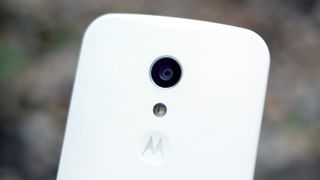Why you can trust TechRadar
One of the most conspicuous changes in the 2014 Moto G is the camera. It has been bumped-up from a 5MP model to an 8MP sensor.
It's not just the sensor that has changed, though. The camera lens is also much, much faster, moving from an f/2.4 lens to an f/2.0 one.
While it's natural to assume the biggest differences will be in the kind of detail you can get in your photos, the most important upgrades are actually elsewhere.
Where the 2013 Moto G is slow to shoot, the 2014 version is pretty fast. It's not Samsung Galaxy S6 fast, but you can take a photo around every second. It makes the new Moto G much more fun to use as a camera, and hugely increases your chances of actually being able to capture the moment when shooting a moving object.

Colour accuracy and contrast are also hugely improved, leading to photos that are much punchier and more accurate-looking than the last model. Motorola has done well in plugging the most serious hole in the first Moto G. There's more detail on show too, although looking closely at the images I think the other benefits are greater.
These improvements make the camera one of the better examples at this price.
The Moto G 2014 edition uses a custom Motorola camera app whose interface is quite different to the norm. Firstly, there's no settings or mode button visible on-screen. You have to flick from the left side of the screen to bring up the mode dial.
Here you choose whether or not to use HDR, whether to use the single-LED flash and so on.
The way you interact with the app is pretty unusual too. Rather than tapping to focus and then pressing a virtual shutter button, you drag a reticule around and any tap on-screen takes a photo.
Motorola seems pretty proud of the app, but I'm not entirely convinced by it, having used it on numerous phones. Your interaction with it feels less direct when selecting the focus point. Dragging the reticule is simply slower and more fiddly than the usual two-tap (focus, capture) approach.

Motorola also arguably needs to rethink its metering approach, as it introduces one of the few recurring image quality problems I saw in the Moto G 2014. The reticule acts as both a focus point and metering point, with just a very small area used to judge the right exposure level.
What this means is you often end up with images that have quite severely overexposed bits. And there's no way to separate the focus and metering points, as there is on some recent phones, and some custom camera apps.
The most obvious fix for Motorola to apply would be to alter the metering so that it's not based on just the one spot, as Apple's iPhones do. However, all you can do at present is to use Auto HDR mode, which will turn on HDR when there's too great a variance of light levels in a scene.
To be fair: the Moto G HDR mode is pretty good, and using it is when I got the best results out of the phone. However, HDR photos are not normal photos, and take significantly longer to capture than standard ones.
For the non photo nerds out there, HDR involves merging multiple exposures to reveal more detail in areas of high and low light intensity.
In low-light the new Moto G performs reasonably well too, up to an extent. What's impressive is how well the phone holds onto its colour right into the night. Other phones' photos tend to look undersaturated with less light to work with, the but this phone bumps up saturations to ensure they still look lively.
If anything, they can at times be a bit more vivid than they are in real life, especially with dusk skies, but the actual tones are pretty accurate.

What the Moto G doesn't have is real provision to make photos clear when there's hardly any light to work with. Sony's top phones like the Xperia Z3 really ramp-up sensitivity and brightness to make objects clear without using the flash. Here, dark areas stay pretty dark-looking.
One of the 2014 Moto G's most convincing rivals, the Asus Zenfone 5, offers an extra mode that reduces resolution to increase clarity and reduce noise – a decent solution that's missing here. However, considering the price I still think low-light performance is pretty good.
The autofocus is able to work pretty well with little light, making night usability decent too.
Video capture is not as good though. You can only shoot at 720p resolution, not 1080p, and the footage looks quite sharpened and harsh, perhaps to try and make up for this.
Footage is still usable, though. The exposure compensation moves fairly smoothly when the Moto G switches between shooting bright and darker scenes, and the camera continually autofocuses when shooting.
You don't have manual control over what the Moto G re-focuses on, though, as tapping the screen takes a still photo rather than refocusing. There's a neat extra too. You can shoot video at 120fps slo-mo, again in 720p resolution. It's good fun.
The front Moto G camera uses a 2MP sensor, up from 1.3MP in the first version. It's really quite good at bumping-up the brightness to make sure your selfies are quite nice and clear, even if they are a bit noisy. For a budget phone, it's a good front camera.
Andrew is a freelance journalist and has been writing and editing for some of the UK's top tech and lifestyle publications including TrustedReviews, Stuff, T3, TechRadar, Lifehacker and others.


